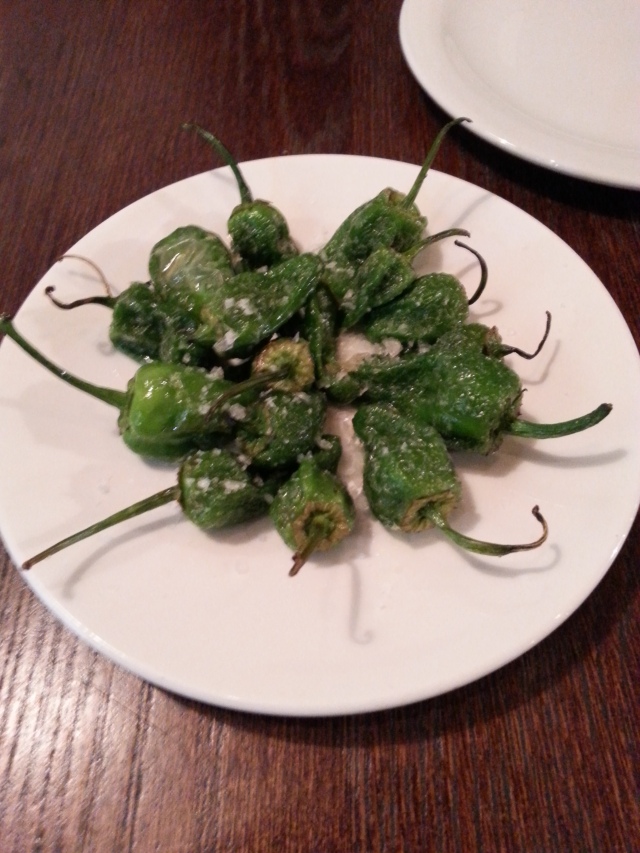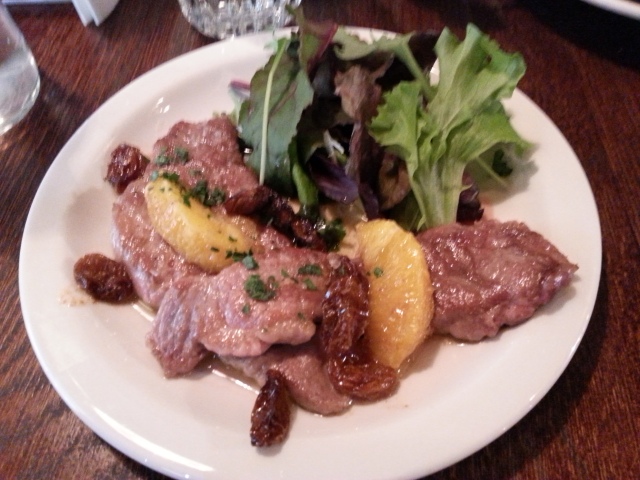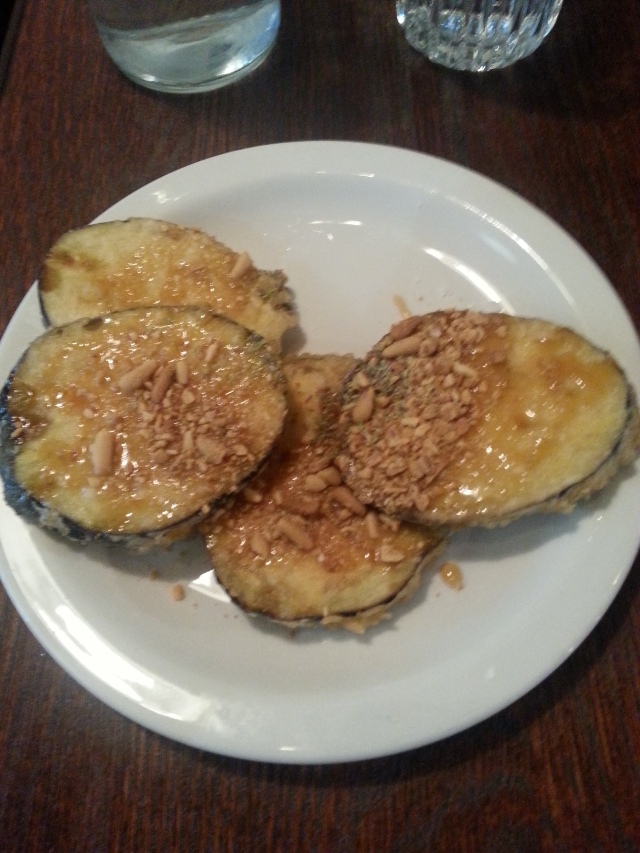
We went for lunch to check out Tramontana Brindisa in trendy Shoreditch.
The restaurant is light and airy, with a great outside terrace at the rear of the restaurant.
Whilst we made our menu choices, we snacked on Padron peppers [£4.50] which had a dusting of sea salt.

Our mains included Lamb Chump on a bed of sweet potato mash [£9.00], succulent pieces of medium meat complemented by the sweetness from the mash; Chorizo in red wine [£5.95], mini chorizo morsels complemented by the flavour of the red wine it was cooked in, but sadly swimming in too much olive oil for our liking; and Fideua de Sepia (short pasta similar to vermicelli with cuttlefish, prawns and a flamed roasted garlic alioli) [£11.00], which C thought was ok but was not a fan of the crispy pasta on the outside, whereas I loved it as it reminded me of tahdig (Persian Rice with a crunchy layer of rice on the bottom) – also we were a bit shocked by the gesture of only two prawns as a decoration on top with small pieces of cuttlefish running through the pasta.
This slideshow requires JavaScript.
Our favourite mains were Grilled Iberico Pork Shoulder Loin [£11.00], with the flavours from its beautiful acorn fed pork working with the flambe orange and raisins like sunshine on a plate; as well as the Berenjenas fritas (fried aubergines) [£5.50] which had a wonderful texture and flavour combination made in heaven of aubergine slices coated in semolina, fried and drizzled with chestnut honey and pine nuts.

Grilled Iberico Pork Shoulder Loin

Berenjenas fritas
Next time, we will need to save space for some dessert as we had our eye on the Tarta de Santiago (Almond Cake) [£4.75] and the Torrijas (milk soaked bread with honey and spices, dipped in egg and fried in olive oil, similar to pain d’epice/ French Toast) with Apple Crumble [£4.00].
Twitter: @Brindisa #Tramontana #Shoreditch
http://www.brindisatapaskitchens.com/tramontana-brindisa-shoreditch/
Tel: 020 7749 9961
Email:reservations@tramontanabrindisa.com
152 Curtain Road, London EC2A 3AT

About goantolondon
International food and travel blog by London based British Goan duo: Jason and Chiara Pinto.
Twitter:
@goantolondon
@jasonpinto100
@chiarapinto
About Goa:
Goa is a small state on the western coast of India. Though the smallest Indian state, Goa has played an influential role in Indian history. Goa was one of the major trade centers in India, thus it had always been attracting the influential dynasties, seafarers, merchants, traders, monks and missionaries since its earliest known history. Throughout its history Goa has undergone continual transformation, leaving an indelible impression on various aspects of its cultural and socio-economic development.
History of Goa:
The East-West symbiosis of Goa makes it different from other parts of India, more than the historical and social niche. The history of Goa is a sweet and sour story of colonial heritage, oppressive rulers, a glorious culture, and uneventful immediate past.
As a land with the identity of its own, Goa was brought into focus when it was liberated of Portugal from its oppressive rule of around 450 hundred years in 1961. Goa was captured and annexed to the Portuguese in 1510 following the urges of trade and demand of spices and also cottons and indigo. But, Goa has a history that starts much before Portugal even thought of Goa being where it is.
Goa was coveted and ruled by a great number of Indian kingdoms and dynasties from the 4th century onwards. The first kingdom to rule Goa and Konkan were Bhojas, who were the feudatories of Ashoka in 4th and 5th centuries AD. The city of Chandrapur (present Chandor) was founded by Prince Chandraditya, son of Chalukya King Pulakesin from 566 to 597 A.D. after this, Goa was ruled consecutively by Silahara Dynasty, Kadamba Danasty, and finally Hoysalas from 1022 to 1342 A.D.
From the 14th century onwards, Goa became a great trading center on the west coast, especially in the vast trade of horses imported from the Middle East. This was the time for bigger empires to move in and Vijayanagar Empire conquered it in 1344. But there empire was not going to last too long and in 1347, Bahmani Sultans defeated Vijayanagara forces in 1347 and controlled Goa. Afterwards, it was a time of great prosperity and peace for Gpa, especially during the rules of Yusuf Adil Shah and Ismail Adil Shah. They created beautiful houses, fortified Goa, and encouraged local craftsmen. Their liberal and progressive rule was not going to last too long and situation changed in 1510 A.D.
Goa for all purposes was not on the Portuguese Radar even after a long time of their presence in India. When the Portuguese nobleman Alfonso de Albuquerque and his cousin Francisco de Albuquerque were sent with a powerful fleet in 1503 on the orders of King Dom Manuel I, the purpose was to defend the cargoes of spices, mostly pepper, against Arab Muslim raiders.
The center of spice trade was Calicut at that time and Portuguese had built forts in Cochin and Cannanore. It was in 1506-08 that an opportunistic pirate, Timoja, persuaded Albuquerque to attack Goa and acquire a better land base. This made Goa, Portugal's first real territorial acquisition in Asia. After a brief period of recapturing by the Muslims, Goa Albuquerque finally captured Goa in 1510.
The inquisition of Goa in 1540 reversed the previous liberal policy of Albuquerque and imposed strict censorship of literature and new laws to forbade non-Christians from professions. Forced conversions took place continuously, censorship was established on literature, the temples were destroyed, and non-Christian priests, holy men, and teachers were evicted. This led to continuous fleeing of Hindus from Goa to other parts of India.
It is not that the relationship with Portugal brought only destruction for the Goans. Portuguese also built great churches like the church of St. Cajetan and Bom Jesus basilica in Old Goa, which is a pilgrimage site for the Christians from around the world. But it is also true that pre-1961; Goa was a highly impoverished region very backward and primitive. It is after the liberation that Goa of today has emerged and it has surprised even the locals many of whom had left their homeland before its liberation. Portugal and India are today friends and Goa continues to be a fascinating blend of Latin and Oriental.
Information sourced from:
http://www.royalorienttrain.com/goa/goa-history.html





























Pingback: Tapas Brindisa Shoreditch | goantolondon